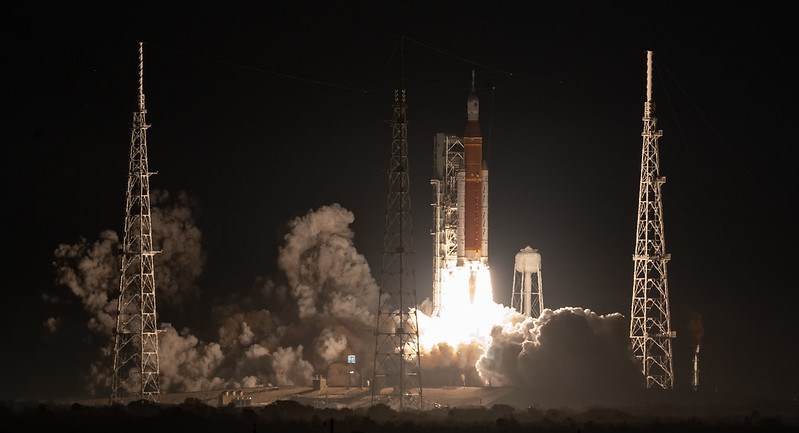We’re on our way back to the Moon.
In the wee hours of the morning, NASA finally got the 322-foot-tall Artemis I off the ground. This was the third attempt to launch the $4.1B Mega Moon Rocket. Previous attempts dating back to August were foiled by leaky hydrogen lines, faulty sensors, and two hurricanes.
The journey to launch has not been a smooth one. Last week, NASA made the decision to leave SLS at the pad during Hurricane Nicole rather than rush it back to the Vehicle Assembly Building (VAB).
- “Rush” may be a bit of a misnomer…at 6.65 million pounds, the Crawler-Transporter 2 that hauled SLS to and from the pad has a top speed of 1 mph while loaded with the mega rocket.
- And while we’re talking mind-bending statistics…SLS can carry 27 tons (59,500 lbs.) to orbits beyond the Moon, per NASA.
But, back to Hurricane Nicole…The high winds, exceeding the rocket’s design limitations, did cause some minor damage—peeling off a strip of sealant where the rocket meets Orion and damaging an electrical fitting—but the mission management team decided on Monday that these risks were acceptable and gave the go orders for the third attempt.
And early this morning, the countdown was halted due to an on-and-off leak with a hydrogen valve and a radar glitch. In one of the more memorable—and hair-raising—moments of the morning, NASA paused hydrogen fueling and dispatched a “red crew” to the pad (and into the blast danger zone) to ensure a valve in the base of the mobile launcher remained tight.
Third time’s the charm
At 1:47am ET, the world’s most powerful rocket (for now) lifted off from the historic Launch Complex 39B at the Kennedy Space Center. Artemis I was hoisted spaceward by two solid rocket boosters and four RS-25 engines. The vehicle passed through Max Q—the point in which a rocket experiences maximum mechanical stress—at ~T+1:08.
At T+8:30, SLS’s core stage separated from the interim cryogenic propulsion stage (ICPS). In space, ICPS completed an ~18-minute trans-lunar injection burn, and roughly two hours after liftoff, the human-rated, uncrewed Orion spacecraft fired its thrusters and separated from the ICPS.
But ICPS’s job was not done—the stage also deployed ten cubesats that will perform a variety of science mission over the coming months.
More importantly, Orion is now on its way to lunar orbit.
What’s next?
Orion’s journey to the Moon will take several days. At its closest approach, the spacecraft will be about 60 miles from the surface. The craft will use the Moon’s gravity as a slingshot to propel itself ~40,000 miles further, breaking the distance record set during the Apollo era for a human-rated spacecraft.
Later, Orion will swing back from that distant retrograde orbit and use the Moon’s gravity once again to swing back towards Earth, splashing down nearly 26 days after launch.
What they’re saying (or playing)
- NASA Administrator Bill Nelson, at the chipper hour of 5AM, said in a post-launch presser that “what we saw tonight, it’s an A+.”
- Launch Director Charlie Blackwell-Thompson told her team: “You have earned your place in the room…You have earned your place in history…What you have done today will inspire generations to come.”
- Trent Annis, part of Artemis’s red crew, said that he “was ready to get up there and go,” after getting the call to head to the pad.
- At 3:49am ET, NASA posted a pre-recorded performance of “The Star-Spangled Banner” by singer Josh Groban and jazz pianist Herbie Hancock.
- Separately, cellist Yo-Yo Ma performed a rendition of “America the Beautiful” with the Philadelphia Orchestra to commemorate the launch.




